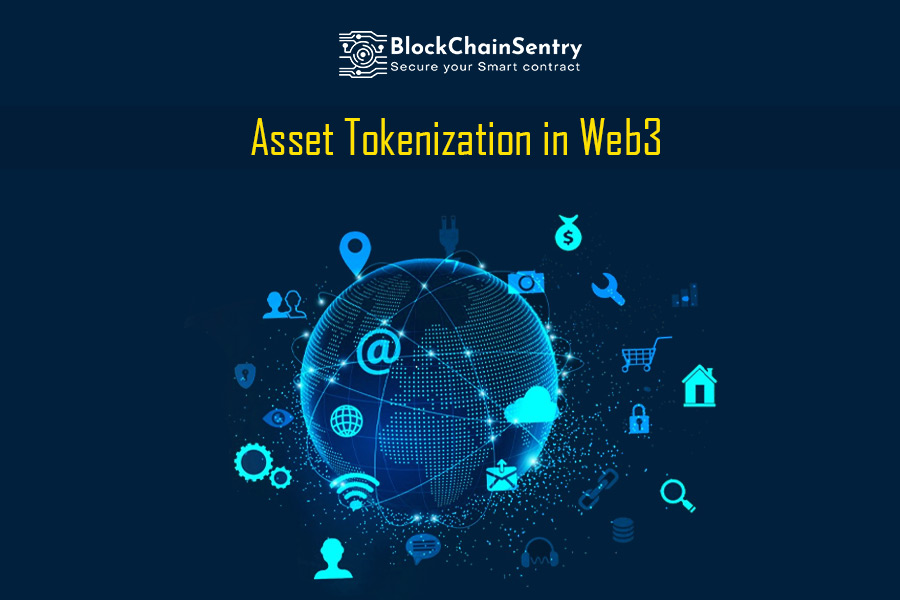Asset Tokenization in Web3

The wizards of the industry tell us that blockchain technology is the future and that the success of businesses in the coming years will depend upon their capacity to accept and apply this new technology in business processes. One of the major breakthroughs in blockchain technology is the tokenization of assets that can help achieve frictionless business processes with internet (web3) integration, where tokens will work as integrators for web services. Several blockchain applications would improve organizational efficiencies through asset tokenization, and as recent studies predict, the market for tokenization will reach $16 trillion by 2030.
Beyond Bitcoin (BTC), asset tokenization is a use case for blockchain technology that makes it possible to buy, sell, and trade digital assets on the distributed ledger. For instance, digitizing real estate assets helped create a less liquid asset that allowed immutable transactions. Tokenization can transfer digital goods or digital copies of physical assets. This can be utilized in any industry or sector, including real estate, automotive, logistics, insurance, bullion, fashion, entertainment, etc. Let's try to learn more about asset tokenization in this blog post.
What is Asset Tokenization?
Under asset tokenization, an issuer produces digital tokens on a distributed ledger or blockchain representing either digital or real assets. Due to the immutable nature of blockchain, once you purchase tokens that represent an asset, no one authority can remove or alter your ownership of that asset. This is made possible through cryptographic tokens, also known as fungible and non-fungible tokens (NFT).
How does Asset Tokenization Work?
Smart contracts are used to control and carry out the operations of digital tokens. The terms of the parties' agreement are incorporated into existing lines of code on the blockchain network, resulting in a smart contract that is self-enforcing and self-executing. A smart contract that makes contractual terms and historical data publicly available allows for the direct delivery of tokens to investors once the contract's parameters have been met. This increases efficiency and transparency for all parties involved.
To represent different asset kinds, the Ethereum community has created some token standards. These standards simplify adoption of distributed assets and enable compatibility between various blockchain projects. A token standard is a group of predefined functions that can represent the distinctive properties of an item. The essential characteristics of the asset, such as its fungibility or nonfungibility, should be considered before choosing which token standard to utilize. There are typically three major types of standards
- ERC 20 - Fungible Token
- ERC 721 - Non-Fungible Token
- ERC 1400 - Security Token
Assets that can be tokenized
Since tokenization supports proof-of-ownership and fractional ownership, the options are virtually limitless. Companies worldwide use blockchain technology to tokenize nearly anything, from conventional assets like venture capital funds, bonds, commodities, and real estate properties to unique assets like sports teams, racehorses, artwork, and celebrities. Assets can be classified into four major categories. Many industries like finance, real estate, healthcare, sports, art, and enterprise have actively started their pilot on tokenization.
Asset: Anything that can be converted into cash is an asset. Money, real estate, and gold are an example of assets. Users can tokenize these assets to claim proof of ownership and identity.
Equity: Equities like shares may be tokenized, but the assets continue to exist as security tokens that users can keep online in a wallet. Usually, investors purchase shares with the help of a stock exchange, but with Equity being tokenized, they can buy it without needing a stock exchange.
Investment Funds: One asset which investors can tokenize is an investment fund; these tokens reflect a shareholder's stake in the fund. Tokens for each investor's portion of the fund are given to them.
Services: Tokens can be used by investors to pay for the supplier's goods or services.
Benefits of Asset Tokenization
Greater Liquidity: The difficulty associated with issuing, buying, and selling securities is reduced with the help of digital tokens. Asset class like fine art and collections can be traded on the secondary market, giving buyers and sellers more liquidity.
Immutable Record: Sellers and investors can learn information about the token's initial owner, the current dealers, etc., with the help of an immutable record of ownership and rights directly integrated into the token.
Reduce Transaction Fees: By lessening the administrative effort of evaluating and certifying transactions, automated smart contracts aid in lowering transaction costs and accelerating transaction processing.
No Third Parties: Startups using asset tokenization can now access tokenized funds directly with the help of blockchain technology. Additionally, because security tokens are liquid, investors can trade them anytime on international secondary markets.
Final Thoughts
Without question, converting assets digitally has gained popularity and made blockchain widely accepted. Institutions and investors are beginning to see the significant value benefits of openness, accessibility, and independence from intermediaries in asset management. However, investors must not take asset-backed tokenization lightly. To choose the ideal platform for your needs, you must understand more about tokenization. As a novel concept, asset-backed tokenization may or may not be subject to regulatory requirements in your jurisdiction. Despite this, numerous businesses are eager to enter this lucrative sector, and billions of dollars worth of assets have already been "tokenized." BlockChainSentry is a leading provider of Asset Tokenization in Web3. Website: blockchainsentry.com.